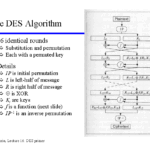In the sprawling labyrinth of digital security, where data flows like the lifeblood of modern society, quantum computing looms as a transformative force. It possesses the potential to alter the landscape of cybersecurity, much like a master sculptor reshapes marble into an exquisite form, unveiling the sublime from the banal. To understand the implications of quantum computing on cybersecurity, one must first delineate its fundamental nature and the vulnerabilities of classical systems.
Quantum computing operates on principles that diverge significantly from classical computing. Classical systems utilize bits as the smallest unit of data, which exist as either a 0 or a 1, akin to a light switch that can either be off or on. In contrast, quantum bits, or qubits, can embody a state of superposition, representing both 0 and 1 simultaneously. This property enables quantum computers to process vast amounts of information in parallel, achieving unprecedented computational power. Imagine a library where each book is open to every page at once, allowing for instantaneous access to a wealth of knowledge.
The ramifications for cybersecurity are both exhilarating and terrifying. Most traditional encryption algorithms, such as RSA and ECC, rely on the computational difficulty of certain mathematical problems. For instance, RSA depends on the challenge of factoring large prime numbers—a task that classical computers struggle with but can manage with sufficient time. However, quantum computers operate with algorithms, such as Shor’s algorithm, capable of factoring these numbers exponentially faster. This ability translates to a chilling prospect: once quantum computing matures, what is currently secure could become precociously vulnerable, akin to an impenetrable fortress crumbling under siege.
The magnitude of this potential vulnerability cannot be understated. If quantum computers can render existing encryption methods obsolete, the privacy of communications, the security of financial transactions, and the integrity of sensitive governmental data all hang in the balance. The digital realm is akin to a vast ocean, where boats built on fragile wooden frames may soon be outmatched by a monstrous sea creature—an endeavor to hold back the tides of breach becomes increasingly Sisyphean.
However, the emergence of quantum computing does not herald an era of existential crisis for cybersecurity. Instead, it ignites a clarion call for innovation. The cybersecurity domain now faces the imperative of developing quantum-resistant cryptographic algorithms, often collectively termed post-quantum cryptography. These algorithms are designed to withstand the computational whims of quantum machines, ensuring that digital communications can remain secure as we transition into this new era. Just as the medieval blacksmiths forged swords capable of withstanding dragon fire, today’s cryptographers must craft algorithms impervious to quantum assaults.
Moreover, the development of quantum key distribution (QKD) represents a beacon of hope amid this tempest. QKD utilizes the principles of quantum mechanics to facilitate secure communication by enabling two parties to exchange encryption keys with a guarantee of security. The Heisenberg Uncertainty Principle plays a pivotal role here; any interception of the quantum key changes its state, thus alerting the parties involved. This process can be envisioned as a sealed message in a bottle cast into the sea; if anyone dares to tamper with it, the contents are rendered unreadable. This new paradigm signifies a departure from traditional methods and encourages a collaborative fortification against potential threats.
Yet, as we tread further into the quantum realm, it is vital to confront the cascading complexities that arise. The integration of quantum technologies into existing systems presents formidable challenges. Legacy infrastructures may struggle to implement post-quantum algorithms without significant investment, akin to an antiquated ship trying to navigate the krakens of the modern world. There exists a pressing need for harmonizing quantum benefits with operational resilience. Adjustments must traverse the labyrinthine corridors of organizational structures, entwining the old with the new.
Furthermore, concerns surrounding the accessibility and equitability of quantum computing technology must be addressed. As with any new frontier, the risk of exacerbating the digital divide looms large; these powerful capabilities may become concentrated in the hands of a few, potentially leading to disparities in cybersecurity readiness among nations and organizations. This power dynamic could foster an environment reminiscent of feudal societies, where fortified walls guard the privileged, while the unprotected languish in the shadows.
In conclusion, the advent of quantum computing introduces a dichotomy in the realm of cybersecurity—an unparalleled opportunity for advancement shadowed by significant risks. The transition necessitates a concerted effort across sectors to develop robust solutions that safeguard our digital existence. Cybersecurity professionals must wield creativity and collaboration like a sword and shield, ready to defend against the encroaching specter of quantum threats while embracing the potential of this groundbreaking technology. The journey forward requires a commitment to evolving alongside this unprecedented shift, forging a path that intertwines resilience with innovation, ensuring that as we navigate the digital seas, we remain steadfast against the turbulent waters ahead.









Leave a Comment